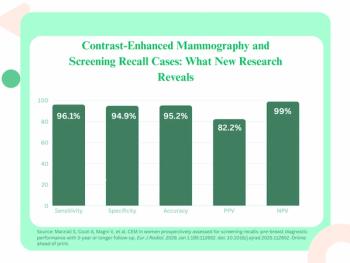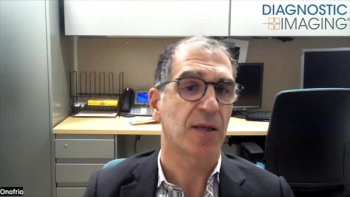
New clinical trials attempt to prove CT angiography's worth
Multicenter studies offer new data that help define both limits and potential of technique in practice
More studies are needed to demonstrate CT angiography's value over coronary angiography, if the technique is to become fully established and accepted by major insurers. That message was delivered loud and clear by researchers at the Stanford Multidetector-Row CT symposium in June, who presented a range of work defining the pros and cons of the technique. Studies published to date have focused on 16-slice scanners, which present multiple limitations for cardiac imaging compared with newer 64-slice systems.
For example, the utility of 16-slice CT angiography could face scrutiny in the wake of a major multicenter trial that found positive predictive values for CTA significantly lower than those reported in single-center studies. The results, previewed at the Stanford meeting, were subsequently published in July (JAMA 2006;296:403-411).
While other major studies of CTA have yielded excellent results, with high negative predictive values, all have been performed in single centers. The distinction is important, said Dr. Mario Garcia, a professor of medicine at the Cleveland Clinic and lead author of the Computed Tomographic Scanning and Catheter Angiography (CATSCAN) study.
"With single-center studies, there might be a bias. Studies that do not have the best results are less likely to get published. Accuracy parameters may be overestimated," Garcia said at the Stanford meeting.
He noted that single-center studies indicate a wide range in the number of segments that cannot be evaluated with CTA, from 5% to 20%. In some of these studies, only a small number of patients were enrolled.
"Our data suggest that the number of nonevaluable segments is slightly larger than single-center trials, and that per-segment and per-patient positive predictive values are lower than what has been reported in single studies. Per-segment and per-patient negative PPV are relatively the same," Garcia said.
The CATSCAN trial included 238 patients from 11 centers in the U.S., Europe, Japan, and Israel. Researchers evaluated use of CTA in patients with suspected coronary artery disease who were referred for nonemergent angiography.
Those with a calcium score of 600 or above went straight to conventional angiography, and the others were scanned with CTA. The prevalence of disease in this second group of 187 patients was 32%.
One criticism of CTA trials has been that when cases are inconclusive they are often excluded from analysis, which artificially inflates CTA performance, Garcia said. But in the real world, if a CTA study is inconclusive, a patient typically goes on to conventional angiography. Consequently, in the CATSCAN trial, inconclusive results were considered to be positive, which explains lower PPVs relative to studies conducted in the past.
Almost 30% of segments could not be evaluated, which limits the utility of 16-slice CT, researchers concluded. After classifying all nonevaluable segments as positive, they further concluded the following figures for detection of luminal stenoses greater than 50%:
- sensitivity, 89%;
- specificity, 65%;
- PPV, 13%; and
- NPV, 99%.
A per-patient analysis of stenoses greater than 50% with inconclusive results (and thus classed as positive) demonstrated sensitivity for detecting patients with at least one positive segment of 98%, specificity of 54%, PPV of 50%, and NPV of 99%. By contrast, past studies have indicated PPVs of over 70%.
For detection of luminal stenoses over 70%, sensitivity was 94%, specificity was 67%, PPV was 6%, and NPV was 99%.
Due to difficulty in evaluating a large percentage of segments and the high rate of false positives, Garcia and colleagues concluded that 16-slice CT could help exclude disease in patients with suspected false-positive or inconclusive stress tests. However, routine use for patients with risk factors is not justified, because such practice could result in too many false positives and unnecessary follow-up care.
"Follow-up tests can be expensive and possibly dangerous to the patient. CTA should be used only in context of the correct clinical indication and is not a substitute for good clinical judgment," Garcia said in a postmeeting interview.
He also noted that 64-slice CTA might yield better performance.
EVIDENCE-BASED QUERIES
Other questions about CTA's ability to replace conventional angiography were raised by Dr. David Kandzari, an assistant professor of interventional cardiology and genomic sciences at Duke University's Center for Evidence-Based Practice.
"Utilization of CTA is exceeding evidence in routine clinical practice and substantiates the need for appropriateness criteria, as we await further trials that will clarify its role in treatment and decision-making," he said. "There is no definitive evidence that CTA provides a useful adjunct to x-ray coronary angiography for native coronary evaluation. There are no empirical data about availability, convenience, or resource implications."
Kandzari's perspective is based on his own research on CTA as well as an evidence-based report from Duke that was commissioned by the Agency for Healthcare Quality and Research. The report was presented to the Centers for Medicare and Medicaid Services in June.
Published coronary CTA trials are often biased and small, and elderly patients are poorly represented, Kandzari said. As a result, it's difficult to generalize positive results for Medicare patients in whom disruptive calcification can be more common.
Duke researchers identified key articles that support the use of CTA versus conventional angiography for assessing native coronary arteries. Articles had to be peer-reviewed and published (abstracts and presentations were excluded). Researchers paid particular attention to whether trials were prospective, if consecutive patients were analyzed, and if patients in the trials were Medicare beneficiaries. They also assessed variability in reported outcomes, including per-segment and per-patient analyses.
"When considering these studies, as with all trials, it is noteworthy to recall that sensitivity and specificity may vary according to populations tested. This is especially relevant because of the rapid evolution of CTA. Proof-of-concept studies often use clinically obvious cases for initial evaluation of diagnostic performance. This overestimates performance," Kandzari said.
DOCUMENTING ACCURACY
Multicenter trials will aid greatly in the assessment of CTA. In addition to the CATSCAN study, results from a Japanese trial of 16-slice CTA were presented at the Stanford symposium. Researchers found 16-slice CTA highly accurate in detecting coronary stenoses. The prospective trial was performed at six major cardiovascular centers; involved 114 patients with suspected coronary artery disease; and used scanners from Siemens, GE, and Toshiba.
Out of 1493 segments, 1360 (91%) were interpretable, said Dr. Sachio Kuribayashi, radiology chair at the Keio University School of Medicine in Tokyo. The remaining 9% were not accessible, mainly due to severe calcification or motion artifact.
Of the interpretable segments, researchers reported sensitivity and specificity of 85% and 95%, respectively; positive predictive value of 76%; and negative predictive value of 96%.
"Our results are similar to what has been reported in single-center studies in terms of sensitivity and specificity, NPV and PPV, and on equipment from different vendors. Sixteen-row CTA detected significant coronary stenosis with high accuracy," Kuribayashi said.
But the extent to which such results can be generalized is unclear, due to the fact that body mass index in Japanese patients is lower than for other patient populations, Garcia said. With obese patients, the number of nonevaluable segments tends to be higher.
Other researchers have moved ahead to capitalize on the cardiac assessment capabilities of 64-slice CT devices. At the Stanford meeting, Dr. Joao Lima discussed the CorE 64 study (Coronary Evaluation on 64), which is assessing 64-slice technology relative to catheter angiography in patients with suspected coronary artery disease. Over 300 patients are taking part in the trial, which includes nine centers in seven countries.
"Sixty-four-slice CT angiography may become the test of choice for symptomatic patients with intermediate likelihood to develop coronary artery disease. Multicenter trials such as CorE 64 are crucial to establish its effectiveness," said Lima, director of cardiovascular imaging at Johns Hopkins University.
Ms. Hayes is feature editor of Diagnostic Imaging.
Newsletter
Stay at the forefront of radiology with the Diagnostic Imaging newsletter, delivering the latest news, clinical insights, and imaging advancements for today’s radiologists.




























